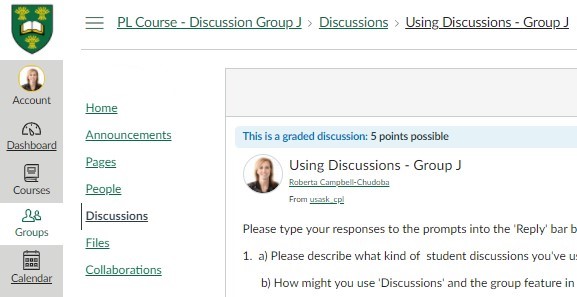Brette D. W. Kristoff, Graduate Student – Communications Specialist, GMCTL, December 2, 2020

Evhan Kristoff, Art History Major Photo credit – B. Kristoff
Whether it be email, instant messaging, or online forums like Canvas Discussions, online communication is our primary mode of communication these days. It’s important to get a handle on how to communicate effectively online.
Here’s a Student Guide for Using Discussions in Canvas:
What are Canvas Discussions?
Discussions are specific to each Canvas course and function as online workspaces for large or small group communication. The Discussions tool might also be used for general classroom communication.
- Ask a course related question or participate in ongoing Discussions threads.
- Smaller groups might be determined by your instructor OR there might be a self sign-up option.
Using Discussions in Canvas may be a part of your course requirements.
- Check your Course Syllabus to see what the course requirements for Discussions are.
Each of your Discussion Groups will have a Group Homepage as shown below:
- Here, you can access all your group members’ contributions with that group.

How do I use Canvas Discussions?
1. Open the appropriate Discussion:
- You may have to post initially before being able to see others’ posts.
- Read through the threads to see all the conversations happening.
2. When you want to make a contribution, start your discussion drafts on a Word.doc. After you’ve proofread your draft, copy/paste it directly to the discussion forum. This way you’ll have all your written discussion contributions in one place for later reference.
- Within a discussion you can reply directly to an individual classmate, however everyone that in that group can view these threads.
- You can attach or embed files/links/images or even a video.
But what do I say?
Online communication has its perks but it can also be intimidating. Often, getting started is the hardest part!
- A great writing strategy to remember is the PEEL acronym…
Point. What point are you trying to make? Clearly state your point of view but also consider the point of view of others. Make comparisons or summarize the points of others. Most importantly, get to the point!!
Evidence and Explanation. Use full sentences to explain your thoughts carefully. Provide referenced evidence for information you share that is not your own. Embed or attach links when appropriate.
Evaluate. Be Critical. Ask Questions.
Link. Always link back to the larger course themes or conversations that have already taken place. This shows that you are engaged in class discussions.
Discussion Board Etiquette
Here are some things to keep in mind when using Discussions in Canvas, email, Canvas Inbox, or any other online communication channel!
- Always use proper capitalization and punctuation.
- Consider your tone and remember that sarcasm and humour are often not appropriate in these types of online forums.
- Make sure your posts are thoughtful and organized neatly.
- Don’t forget to include a formal greeting (‘Hello all!,’ ‘Hi everyone,’ or ‘Good afternoon!’)and goodbye: (‘Thanks for your time,’ or ‘All the best,’).
- Reference the contributions from others by mentioning them by name or by replying directly to their post.
Check out this handy USask netiquette guide for more tips.
We acknowledge that the University of Saskatchewan’s main campus is situated on Treaty 6 Territory and the Homeland of the Métis. We pay our respect to the First Nations and Métis ancestors of this place and reaffirm our relationship with one another.
For more support options with Canvas, see the USask Student Canvas page.




